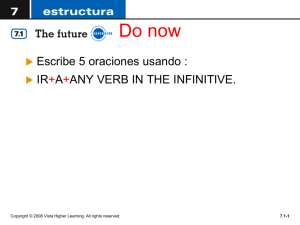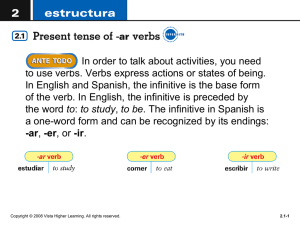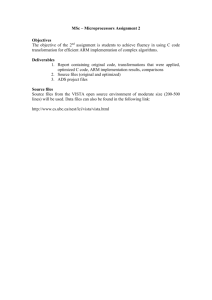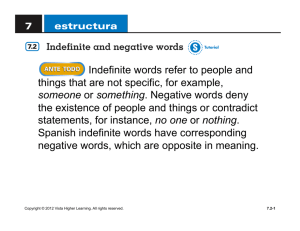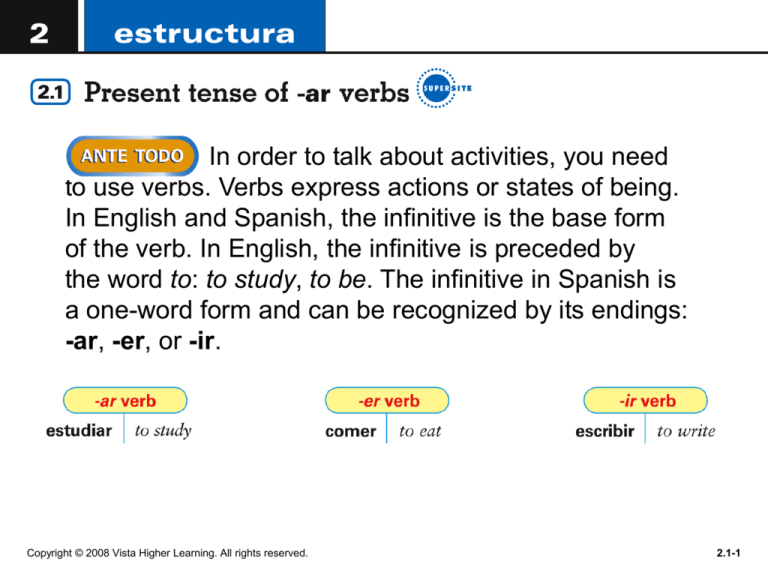
In order to talk about activities, you need
to use verbs. Verbs express actions or states of being.
In English and Spanish, the infinitive is the base form
of the verb. In English, the infinitive is preceded by
the word to: to study, to be. The infinitive in Spanish is
a one-word form and can be recognized by its endings:
-ar, -er, or -ir.
Copyright © 2008 Vista Higher Learning. All rights reserved.
2.1-1
In this lesson, you will learn the forms of
regular -ar verbs.
Copyright © 2008 Vista Higher Learning. All rights reserved.
2.1-2
Copyright © 2008 Vista Higher Learning. All rights reserved.
2.1-3
To create the forms of most regular verbs in Spanish,
drop the infinitive endings (-ar, -er, -ir). You then
add to the stem the endings that correspond to the
different subject pronouns. This diagram will help
you visualize the process by which verb forms
are created.
Copyright © 2008 Vista Higher Learning. All rights reserved.
2.1-4
Copyright © 2008 Vista Higher Learning. All rights reserved.
2.1-5
¡Atención! The Spanish verbs buscar,
escuchar, esperar, and mirar do not
need to be followed by prepositions as
they do in English.
Copyright © 2008 Vista Higher Learning. All rights reserved.
2.1-6
Copyright © 2008 Vista Higher Learning. All rights reserved.
2.1-7
When two verbs are used together with
no change of subject, the second verb is
generally in the infinitive. To make a sentence
negative in Spanish, the word no is placed
before the conjugated verb. In this case,
no means not.
Copyright © 2008 Vista Higher Learning. All rights reserved.
2.1-8
Spanish speakers often omit subject pronouns
because the verb endings indicate who the subject is.
In Spanish, subject pronouns are used for emphasis,
clarification, or contrast.
Copyright © 2008 Vista Higher Learning. All rights reserved.
2.1-9
The verb gustar
To express your own likes and dislikes, use the
expression me gusta + [singular noun] or me
gustan + [plural noun]. Never use a subject
pronoun (such as yo) with this structure.
Copyright © 2008 Vista Higher Learning. All rights reserved.
2.1-10
To express what you like to do, use the
expression me gusta + [infinitive(s)].
Copyright © 2008 Vista Higher Learning. All rights reserved.
2.1-11
To use the verb gustar with reference to
another person, use the expressions te
gusta(n) (tú) or a + [name/pronoun] le
gusta(n) (usted, él, ella). To say that
someone does not like something, insert the
word no before the expression.
Copyright © 2008 Vista Higher Learning. All rights reserved.
2.1-12
To use the verb gustar with reference to
more than one person, use nos gusta(n)
(nosotros) or a + [name/pronoun] les
gusta(n) (ustedes, ellos, ellas).
Copyright © 2008 Vista Higher Learning. All rights reserved.
2.1-13
Provide the present tense forms of these verbs.
The first items have been done for you.
hablar
gustar
hablo español.
1. Yo _____
Me gusta el café. (yo)
1. _________
2. Ellos _____ español.
2. ¿ _____ las clases? (tú)
3. Inés _____ español.
3. No _____ el café. (usted)
4. Nosotras _____ español.
4. No _____ las clases. (ella)
5. Tú _____ español.
5. No _____ el café. (nosotros)
Copyright © 2008 Vista Higher Learning. All rights reserved.
2.1-14

